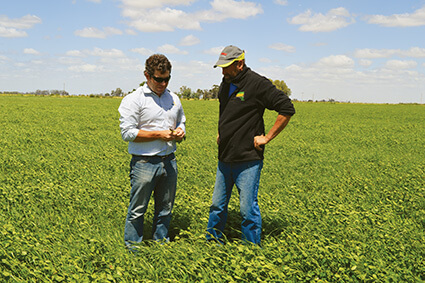
Case
Study
Location
Murrabit, Victoria
Crop
Dairy pasture
John Archard, Murrabit VIC
As a consequence of the drought, John has moved away from summer pasture and now concentrates on maximising fodder conservation (silage) in the spring, which he then feeds out in the summer months. This minimises heat stress within the herd and helps prevent the drop in milk production you would normally see during heat waves.
After each silage cut, the paddock is irrigated and then sprayed with the foliar mix, mentioned above, to maximise both yield and forage quality. With this approach John has been able to achieve 3 to 4 cuts of silage from each paddock in the spring, whilst maintaining pasture production for the herd to graze.
John detailed his key points from growing pasture. “I’m achieving winter pasture production that I was never able to achieve with conventional approaches.”
“The cows are happy to graze the same area for up to four days, whereas with the conventional approach, they would be knocking the electric fence down within a few hours, trying to get back to the feed pad. In fact you have to be careful not to over graze paddocks.”
“Greater palatability of the pasture means greater pasture utilisation.”
“The root system is now extending down to 40cm. Previously they wouldn’t push beyond 5-10cm.” “The cost per hectare is certainly no more than my old approach, if anything it is less.”
“Whilst I have had to purchase a spray cart for the foliars, the advantages far out way the costs, particularly during that winter growth period.”

BioAg Area Manager Dan Hill with John Archard on John’s dairy farm in Victoria.
BioAg program
Autumn (inputs/ha)
- Lime 500kg
- BioAgPhos® 200kg
- Sulphate of Ammonia (SOA) 100kg
- Soluble Boron (past 2 years) 2kg
Winter (inputs/ha)
- Balance & Grow® 2L
- Sulsa (equivalent to 8 units of N and 1.8 units of S) 3L
The first foliar mix is applied in May/June and John normally follows the cows around with the boom spray. Occasionally the paddocks may receive two foliars during the winter months, but that depends on several factors including the season, grazing pressure etc.
“Anyone can grow grass in autumn and spring just by throwing nitrogen down. Where this system stands out is its ability to grow quality pasture from March to December. High protein and high ME feed is what keeps your milk volume and components up.”
Download case study
Download a PDF version of the above case study.

Recent Comments